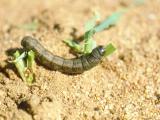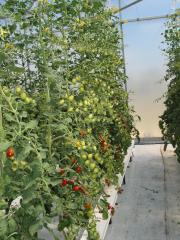Cutworms

Cutworms are several species of caterpillars which live in the soil during the day and attack the plant at night. Young seedlings are the most vulnerable to attack. The cutworms damage the stem at the base causing the plant to collapse.
A stout, brown or black, herring-boned, softbodied, hairless caterpillar about 4cm long may be found in the soil surrounding the plant.
When disturbed, it curls up nose to tail. The caterpillar pupates in the soil and emerges as a medium-sized, grey-bodied moth with dark wings. Prevent cutworm attack by placing small, open-ended plastic cups around plants or by wrapping plant bases with aluminium foil. Cutworms are only active at night, so go out after dark with a torch and check for caterpillars at work.
Control with evening sprays of bacillus thuringiensis, spinosad, diazinon, cyfluthrin, or pyrethrin.
Looper caterpillars
These are voracious foliage feeders of tomatoes, potatoes, and other vegetables. They are soft-bodied caterpillars, usually green with bright-coloured bands on either side of the body, and are about 40mm long when fully grown. They move with a distinctive looping action. Mainly found in the summer, they eat large holes in the foliage and may attack young flowers and fruit.
The insects pupate in the soil and emerge as brown, medium-sized moths which are sometimes active during the day. They have silvery marks on the forewings.
Control with sprays of bacillus thuringiensis, spinosad, cyfluthrin, or diazinon.
Two-spotted mite or red spider mite

A serious summer pest of tomatoes, two-spotted mites are usually first noticed by the appearance of the leaves, which begin to look scorched, russetty and dry. The undersides of the affected leaves usually have fine webs concealing hundreds of small, green to red mites and pearly eggs. The mites suck the sap of the leaves and breed very rapidly in warm weather.
When the infestation becomes severe they are almost impossible to control as they are present in such large numbers. They are also resistant to many sprays.
Numbers can be reduced by spraying water beneath the leaves.
Organic sprays must also be used beneath the leaves and include horticultural (potassium) soap and wettable sulphur. Insecticides include dicofol and dimethoate.
